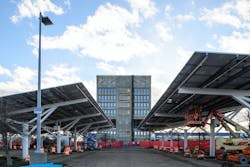Hotel microgrids cut energy costs, meet demand from guests for sustainability
Travelers are looking for accommodations that meet sustainability goals, and a hotel microgrid can help meet that demand with financial help from federal incentives and participation in energy markets.
Travelers have good reason to search for sustainable hotels. Because hotels operate 365 days a year, 24 hours a day and include refrigeration, they’re one of the highest energy and water consumers per square foot. The average guest room uses about $2,200 in energy costs annually.
Two hotel microgrid projects that aim to meet guests’ sustainability goals are Hotel Marcel, a net-zero hotel in New Haven, Connecticut, that began operating at the end of 2021, and a Marriott hotel in Costa Rica — Marriott Hacienda Belen — whose microgrid is a first for the Marriott chain in Latin America. It is expected to be operating in the next few weeks.
Connecticut hotel microgrid
Hotel Marcel, registered on the National Register of Historic Places and a Hilton-branded hotel, has a grid-tied microgrid with load shedding capabilities that is participating in storage programs to strengthen the northeast grid.
Such hotels catch the eye of environmentally conscious travelers.
“Travelers and customers, in general, are well informed and always looking to minimize the footprint of their activities, and hospitality and accommodation is a very important part of that traveling, hence it’s natural that the customers are looking for responsible suppliers and environmentally conscious experiences,” said Fernando Ortuno, founder of Greenenergy, which developed the Marriott Hacienda Belen project.
Hotel Marcel’s microgrid is made up of two EPC Power PD250 storage inverters totaling 500 kW, LG Chem batteries that can provide 1,012 kWh, SMA CORE1 PV inverters for the 400 kW of solar located on a carport, hardware for islanding the system and additional hardware to drop loads, said Laura Williams, application engineer for Ageto, which provided the ARC controller.
“With a full solar array, microgrids help offset usage in hotels, especially during high usage periods during the day,” said Williams. “Hotels want to make sure the lights aren’t going off on guests. And microgrids help avoid the use of fossil fuels in backup generators.”
The system will detect an outage when it occurs and open a circuit breaker, and the battery and solar system will support critical load panels, she said.
Energy market participation
The Ageto controls communicate to the building management system during peak shaving events to reduce the building load by, for example, lowering the temperature a few degrees. It communicates to the building management system when off-grid mode is active and the building should use energy only for critical operations. It also tells the elevator — a big load — to stop operating during outages, which extends the battery’s life, said Williams.
The microgrid is participating in the New England energy market through Connecticut’s Energy Storage Solutions program. Similar to many grid stabilization programs in the US, the controller is signaled when the grid is strained, and it will dispatch the battery. If there’s excess energy on the grid — generally solar — the hotel’s battery can sink the excess.
“If there is too much solar in front of the meter and more production than consumption, the batteries can be used to absorb some of the solar and make the grid more resilient,” said Williams.
The former office building had been left vacant for 20 years until architect Bruce Becker remodeled it, reusing as much material as possible and focusing on energy efficiency and sustainability.
The financials
The microgrid cost about $2.5 million and was funded through a $2.3 million commercial property-assessed clean energy (CPACE) loan. In addition, the project received a solar federal tax credit of about $182,000. An equity investor has put about $590,000 into the project to leverage the credits.
“So that puts us ahead of the game from day one,” said Becker.
The 700,000 kWh of power produced by the solar panels will save about $100,000 in electric utility charges and the microgrid system management should save about another $19,000 in demand charges per year, said Becker. The project will reap about $32,000 annually in renewable energy credit income and $30,000 of income from Connecticut’s active dispatch program. The total value of these annual savings and program proceeds is $181,000, which covers virtually all of the cost of the CPACE financing, he said.
Less tangible is the value of the resilience provided by the storage. It also sets an example for the hospitality industry, said Williams.
“This definitely makes economic sense, but more importantly helps us achieve our status as a net-zero energy hotel,” said Becker.
Connecticut Energy Storage Solutions program
Costa Rica hotel microgrid
Like the Hotel Marcel microgrid project, the Costa Rica Marriott Hacienda Belen also takes advantage of controls to reap benefits. It uses control and optimization software made by Heila Technologies. The project includes 250 kW of solar, a 360-kW/720-kWh battery storage system and a 1-MVA backup generator.
The system maximizes time-of-use rates by charging the storage at night and discharging during peak hours, said Ortuno from Greenenergy. This also benefits the utility — Compañía Nacional de Fuerza y Luz. The microgrid is expected to reduce electricity consumption by 17% to 20%.
Costa Rica has no load shedding programs that allow customers to get paid to isolate from the grid. The country has no ancillary services either.
“We are working with legislators to enable grid services,” said Ortuno.
Reliability is also an important benefit of the project. Several clients that Greenenergy is working with have experienced about one 15-minute outage per month, said Ortuno. That’s especially true in areas with long rural circuits that often experience outages because of wildlife, wildfires or heavy winds.
With their anticipated financial, environmental and reliability advantages, the two projects are expected to help pave the way for more hotel microgrids that reap numerous benefits in an energy-intensive industry. And they’re also expected to please travelers seeking to lower their carbon footprints.
Learn more about hotel microgrid projects. Subscribe to the free Microgrid Knowledge Newsetter.








